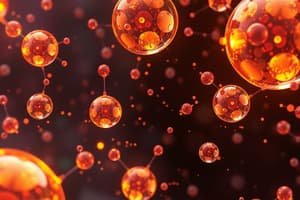Podcast
Questions and Answers
What characteristic of transition metals is associated with their catalytic activity?
What characteristic of transition metals is associated with their catalytic activity?
- High enthalpy of atomisation
- Colour of hydrated ions
- Paramagnetic nature
- Variable oxidation states (correct)
Why do transition metals show catalytic activity?
Why do transition metals show catalytic activity?
- They form stable intermediates
- They have a high enthalpy of atomisation
- They are paramagnetic in nature
- They exhibit variable oxidation states (correct)
Is Copper a non-element?
Is Copper a non-element?
- No, because it has partially filled f-orbitals
- Yes, because it has completely filled d-orbitals
- No, because it has completely filled s-orbitals (correct)
- Yes, because it is a noble gas
In the context of conductivity, why does the conductivity decrease upon dilution of an electrolyte?
In the context of conductivity, why does the conductivity decrease upon dilution of an electrolyte?
What is the formula of the complex 'dichloridobis (ethane-1, 2-diamine) platinum(IV) nitrate'?
What is the formula of the complex 'dichloridobis (ethane-1, 2-diamine) platinum(IV) nitrate'?
Which property of transition metals allows them to provide new reaction pathways with lower energy?
Which property of transition metals allows them to provide new reaction pathways with lower energy?
What is the IUPAC name of the complex [Pt Cl₂(en)) (NO3)2]?
What is the IUPAC name of the complex [Pt Cl₂(en)) (NO3)2]?
Which statement about osmotic pressure as a colligative property is true?
Which statement about osmotic pressure as a colligative property is true?
Why is nucleophilic substitution easier in iodoethane compared to chloroethane?
Why is nucleophilic substitution easier in iodoethane compared to chloroethane?
In the presence of incompletely filled d-orbitals, what is the common oxidation state of copper?
In the presence of incompletely filled d-orbitals, what is the common oxidation state of copper?
Why does iodine exhibit a faster rate of nucleophilic substitution compared to chlorine?
Why does iodine exhibit a faster rate of nucleophilic substitution compared to chlorine?
What happens to the total vapor pressure when equal moles of liquid X and Y are mixed to form an ideal solution?
What happens to the total vapor pressure when equal moles of liquid X and Y are mixed to form an ideal solution?



